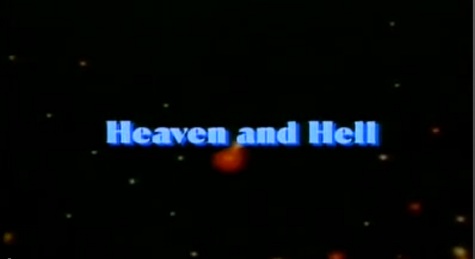The fourth episode of Cosmos, “Heaven and Hell,” deals with “bizarre natural events” and “major catastrophes” on Earth and elsewhere, particularly Venus, as well as the related makeup of comets and asteroids in relation to their place in catastrophic events. That all leads up to a commentary on human-made catastrophic events. (Plus, there’s an “Update” at the end of this one on global warming.)
Coming as it does after an episode that puts faith and science into somewhat oppositional conversation, it seems a strange thing that the fourth episode uses a metaphor straight out of religion: “heaven” and “hell,” with all the attendant value judgments. But, there seems to be a reason for the shift in terms. In a few ways, this episode is functioning as one big allegorical structure; the guiding metaphor of the title, too, ends up having either two meanings, or a meaning that yokes the two arguments of the episode.
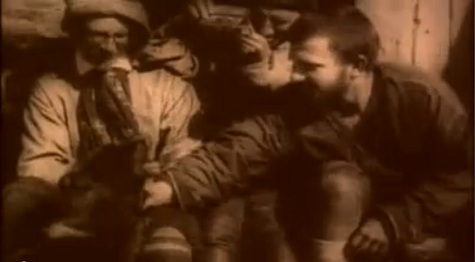
“Heaven and Hell” opens with a discussion of our exploration of “the heavens,” and how our world is like a heaven for us, compared to other possibilities—foregrounding this guiding metaphor as the framework through which the rest of the stuff Sagan talks about is going to be filtered. The fact that there are massive, catastrophic events in the cosmos is the first concern of the episode, and to that end, the Tunguska event is explored as an example (and, eventually, as a way into discussing the sorts of things that often impact planets). As Sagan walks us through the history, we see classic-looking footage; finally, Sagan himself wanders through a desolate landscape and makes a series of points: there was no impact crater, and no meteorite fragments found by the scientists, but an event undeniably happened.
So, what was it? Sagan gives a set of speculative theories that loomed about the strange destructive event: was it possibly dark matter? A tiny black hole? A space-ship crash? A meteorite or asteroid? Finally, he takes us to one answer, noting that: “the key point of the Tunguska event” was that there was “no crater in the ground.” The only answer left, he explains, was that a comet must have hit the earth at Tunguska. Because comets are made of icy material, they melt, leaving no large traces behind. Sagan describes a comet as “like an iceberg in the ocean of interplanetary space,” a lovely metaphor, and Earth’s being in the way of one as “an accident” in cosmic order of things. (We’ll get back to that accident thing in the discussion below.)
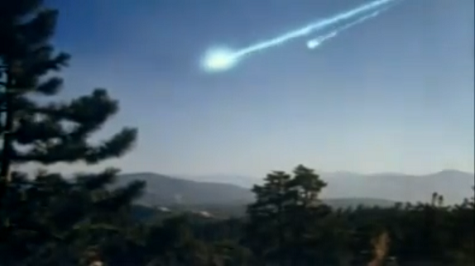
We connect to the next section of the episode with a rather sharp question: could a comet impact now “trigger a nuclear war” in our confusion? As Sagan says, it seems that the “response of our civilization is promptly to self-destruct. Maybe it’s unlikely, but it might be a good idea to understand comets and collisions and catastrophes a little bit better than we do.” On that dark note, we explore the historical role of comets as omens, then the scientific explanations we’ve discovered over the past hundred years or so about them—including some of the weird stuff that was printed in the early 1900s about Halley’s comet. Long and short period comets are explained by Sagan as he walks around a physical model of the universe, pretending he himself is a comet; it’s a useful visual trick. He then notes that, though impacts don’t happen so often anymore, one may have been witnessed in 1178 when an explosion was noted occurring on the moon by monks at Canterbury. (Plus, we proved it with recent experiments!)

Finally, from there, we move into other speculations and theories—particularly about Venus, the “hell” that matches our current Earth’s “heaven.” Sagan moves from Immanuel Velikovsky to spectral signatures used to determine what elements composed the planet’s clouds to the information gained by the Soviet Venera landers. The greenhouse effect, in particular, gets a lengthy exploration. Sagan describes Venus as “a thoroughly nasty place,” a hellish landscape of intense pressures, heat, and sulfuric acid clouds. This destroyed landscape leads us into a discussion of the changes we’re wreaking on earth, natural and otherwise.
“Both the insignificant and the extraordinary are the architects of the natural world,” he says, noting the different sort of things that shape the world we live on. The sphinx is used as an example: weather has worn it down, but soldiers shot off its nose. As he then argues passionately, with intense music in the background, “Shall we then recreate these hells on earth? We’ve encountered desolate moons and barren asteroids, shall we then scar and crater this blue-green world in their likeness?” The then-young state of climate study and pollution study leads him to ask one vital, resonant closing question, referring to what we know of the state of Venus: “Something went wrong. Knowing that worlds can die alerts us to our danger.”
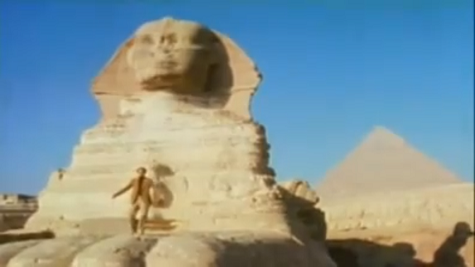
The Update further notes the damage of global warming, 10 years later.
*
In a move that reminds me of the episode about evolution (“One Voice in the Cosmic Fugue”), Sagan approaches a controversial and testy topic in “Heaven and Hell” by angling into it sideways. The difference is that the evolution episode’s end argument is simply that folks should be open to scientific fact—whereas the argument about the destruction of our environment in this episode is impassioned, direct, focused on human folly and ignorance, and quite intensely concerned with making people change their ways before we cause our own apocalypse. Here, this is explained in terms of nuclear war, a recurring concern of Cosmos, but also of pollution, greed, and disregard for the next generation.
The soaring music, disaster footage, and ominous but memorable speech given by Sagan at the end make this the most politicized and outwardly argumentative episode yet, which I find fascinating—mostly because all of it sounds exactly current today, and isn’t that depressing? One longer part of the ending section, in particular, stands out to me:
“[We have] already deadened large patches of the earth’s life-supporting skin, and yet we ravage the earth at an accelerated pace, as if it belonged to this one generation, as if it were ours to do with what we please… The damage becomes irreversible… Our generation must choose: which do we value more, short term profits or the long term habitability of our planetary home? The world is divided politically, but ecologically it is tightly interwoven…. Natural catastrophes are rare, but they come often enough. We need not force the hand of nature. If we ruin the earth, there is no place else to go. This is not a disposable world, and we are not yet able to reengineer other planets. The cruelest desert on earth is far more hospitable than any place on Mars.”
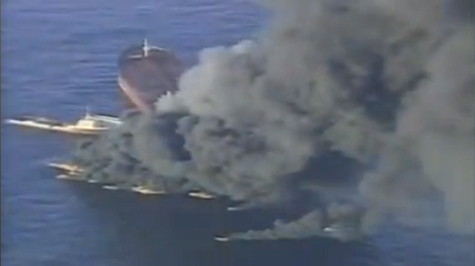
This speech is delivered to footage of burning oil tankers, soiled waterways, deforestation, and the suffering of living creatures like oiled birds—and my god, is it effective. The polemical nature of Sagan’s speech, here, gives me a much better understanding of why the episode functions on an almost religious metaphor: not because of its faith-based nature, but because of its usefulness in demonstrating powerful, cultural intelligible extremes of “the absolute best” and “the absolute worst” while allowing Sagan to make a direct connection between them. We can see, in the form of Venus, what a proverbial and literal hell would be for an Earth that has been long-victim to a growing greenhouse effect. Plus, in the end, these aren’t faith-based issues, they’re scientific facts. We are indeed destroying our planet, and we have nowhere else to go; that hasn’t changed between the 80’s and today. That it hasn’t changed, despite the rhetoric of folks like Sagan across the board of public intellectuals since his time, is deeply worrying.
As Sagan says, and as I hear friends (and myself) saying all the time: if an alien did come here, how would we explain what we’ve done?
On the other hand, though we should be worried by our own human-made destruction of the planet and its environment, we shouldn’t be so damn worried about comets. I particularly appreciated the understated but oft-repeated notion that impacts between planets and space debris/objects are “accidental”—not destined or creating destiny for anything or anyone. They mean nothing, on a mystical or spiritual level, and yet they are made of the same cosmic stuff we are, which is kind of neat.
One final thing that I loved about this episode was a short set of asides taking apart some of the epistemological background of scientific work: (1) “There are many hypotheses in science which are wrong; that’s perfectly all right, it’s the aperture to finding out what’s right. Science is a self correcting process. To be accepted, new ideas must survive the most rigorous standards of evidence and scrutiny…” and (2) “The suppression of uncomfortable ideas may be common in religion or in politics but it is not the path to knowledge, and there’s no place for it in the endeavor of science. We do not know beforehand where fundamental insights will arise from about our mysterious and lovely solar system.”
These little statements are buried in an episode about catastrophes natural and man-made; if you aren’t paying close attention, you might miss them. Yet, I think they’re some of the most provocative and significant statements Sagan makes in the entirety of “Heaven and Hell.” They reveal a distinct sense of what he and his co-creators are working toward explaining to their audience through the work of Cosmos: the mission of science, how it plays into our daily lives, and its relationships to other social institutions like religion and politics. Science, in this view, is not impenetrable or obscure—it is meant to explore possibilities, to speculate, and then to try to prove those ideas about our cosmos and the world we live in, so we can better ourselves. Each episode of Cosmos has these little tidbits worked into its larger argument; the end result, as a science activist and public intellectual like Sagan must have hoped for, was to introduce the theoretical functions of “science” to a wide audience of people who might not have had the chance or inclination to discover them otherwise. He makes it pleasurable, understandable, and visually intriguing in this series—all the things that are needed to make difficult concepts more enjoyable, for a teacher and their students, in any context.
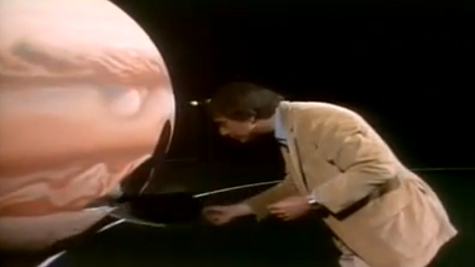
*
Join us in two weeks for a discussion of episode 5, “Blues for a Red Planet.”
Lee Mandelo is a writer, critic, and editor whose primary fields of interest are speculative fiction and queer literature, especially when the two coincide. She can be found on Twitter or her website.










